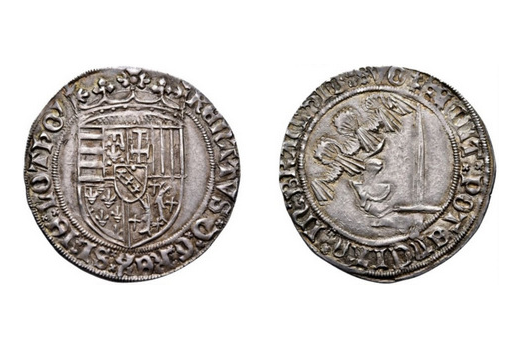
about ancient nomos
Ancient Nomos Art is a museum of galleries exhibiting ancient coins and ancient mint maps. The coin gallery displays the diverse art and history of hand-crafted ancient Greek, Roman, Byzantine, Persian and Medieval coinage. The ancient mints mapping gallery features Greek, Roman, Byzantine, Asia Minor and Medieval mint city regions and territories. Visitor's are welcome to explore, study and enjoy Ancient Nomos Art.

Post-Medieval, France – 1496 AD
Duché René II
From Ancient Galleries

Obverse: Legend, RENATVS D G REX SI IE LOThO\', Crowned-of-arms symbols of all seven ruling territories.
Reverse: Legend, FECIT POTENCIAM IN BRAChIO SVO, Armored arm, emerging from clouds, holding sword.
LEGEND
Obv: RENATVS D G REX SI IE LOThO\’, Crowned arms symbols of ruling territories. Rev: FECIT POTENCIAM IN BRAChIO SVO, Armored arm, emerging from clouds, holding sword.
This interesting and elegant coin is from the Duchy of Lorraine, issued by René II. According to Alan Walker, the coin what was known in Lorraine as a Plaque or Double-Gros (it was a part of a series that included halves and quarters – Gros and Demi-gros). The coin was issued in Nancy, and according to French numismatists, was issued after 1496 AD by Duke René II (1473-1508 AD). Dr. Walker continues to state that the chronologically of this coin was minted during the Renaissance, and there are certainly what were then ‘modern’ stylistic touches to its design, but it basically harks back to the High Middle Ages. The lettering is Gothic, albeit highly legible; the crowned shield bearing the ducal arms could have been made a century before or two centuries afterwards. The obverse crowned shield represents territories controlled by the Duke in quarters including, at 1: left in a of Hungary, in b of Naples; in 2: left in a from Jerusalem, in b from Aragon; at 3 d’Anjou; at 4 de Bar; and on top of all a small shield of Lorraine with field of lilies. However, it is the reverse that Dr. Walker finds most interesting. He comments on how the reverse is definitely forward looking in design concept. Dr. Walker notes, “The legend/caption tells us fecit potenciam in brachio suo – he strengthened his arm, and the “illustration” (the type) shows us an armored arm, coming out of the clouds, with a hand holding a sword. The sword is a badge of the duchy, and is found on coins, often between two eagles, going back centuries. Another example, with the same armored arm emerging from a cloud, dates to the 17th century and appears on a medal of Charles IV, c. 1634, but with a quote from Psalm 67 in the Bible – fugiant qui oderunt eum a facie eius – let them that hate him flee from before his face. But whose armored arm holds this sword in its hand? Normally we would expect that anything coming from the clouds would be divine, like the manus dei we see crowning Roman emperors and empresses on 5th century solidi. But armored? In the later 16th and 17th centuries we commonly see the Hebrew name of God, in the clouds with the rays of the sun, on coins of the Protestant states of Europe, but René II ruled before the Reformation. So is this a ducal arm? Often, what seems to be simple, actually isn’t!”
DOCUMENTATION
Value: Plaque (Double-Gros). Metal: AR Silver. Weight: 3.59 grams. Mint: Nancy, France. Date: Struck after 1496 AD.
Attribution: De Saulcy, plate XIII, 8; Flon, page 566, image 36; Grün 77, June 1998, 1228 (this coin).
Legend, Documentation and Attribution
